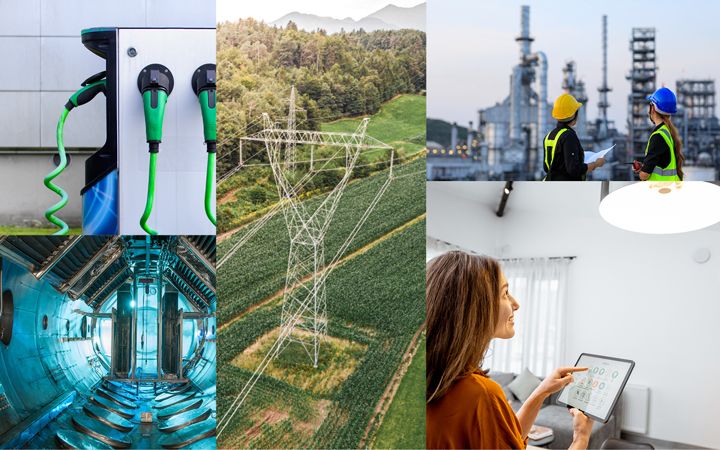
Exploring the ramp-up of hydrogen production in the EU
Objective
ICF, in cooperation with Fraunhofer ISI and Artelys, is carrying out a study for the European Commission. The objective of this study is to support the European Commission in monitoring the ramp-up of hydrogen production in the EU and in third countries, assess the effectiveness of the hydrogen framework and identify possible barriers to the upscaling of renewable hydrogen.
Context
The EU’s hydrogen strategy lays out the European Commission’s vision for hydrogen and its role as an energy carrier in an integrated European energy system. The Strategy considers hydrogen as “essential to support the EU’s commitment to reach carbon neutrality by 2050 and for the global effort to implement the Paris Agreement while working towards zero pollution”. It also places it as “a key priority to achieve the European Green Deal and Europe’s clean energy transition”.
Renewable hydrogen represents a strategic opportunity to decarbonise hard-to-abate sectors, and hard-to-electrify sectors in particular. Ramping up renewable hydrogen production aims to support the achievement of the EU climate neutrality objective by 2050, as part of an integrated energy system.


The EU has made significant efforts to support the viability of renewable hydrogen, including the creation of the EU Hydrogen Bank to support its supply. These efforts also extend to demand-side interventions. Under the Renewable Energy Directive III, by 2030 RFNBOs are expected to account for at least 1% of the total energy supplied to the transport sector, and at least 42.5% of all hydrogen used in industry, rising to 60% by 2035. Additional mandates for RFNBOs are set under the ReFuelEU Aviation and FuelEU Maritime regulations. The Commission’s projections from the Climate Target 2040 Impact Assessment indicate renewable hydrogen consumption of 3-4 MtH2 by 2030, reflecting the EU RFNBO targets from the Renewable Energy Directive.
This supporting policy environment has translated into a steep growth in the announcement of new renewable hydrogen projects, with the EU accounting for the largest share of globally announced capacity by 2030. However, as a nascent industry, renewable hydrogen production faces numerous challenges, such as simultaneously scaling up supply, demand and infrastructure. The 2025 report entitled “The green hydrogen ambition and implementation gap” published by Nature Energy, states that in 2022 only 0.62 GW of electrolysis capacity was operational on time, instead of the 2.8 GW initially announced. Similarly, in 2023, of the 7.1 GW initially announced, only an estimated 0.92 GW became operational.
Study Overview
The study will provide a detailed overview of renewable hydrogen production in the EU and third countries at both project and Member State levels. This will help assess the capacity of Member States to positively contribute towards the EU energy transition and decarbonisation objectives. The assessment of the hydrogen framework will support the review of the 2023/1184 Delegated Act on RFNBOs. Specifically, the study will address the additionality, temporal, and geographical correlation RFNBO criteria for electricity procurement. A brief overview of the criteria according to the current 2023/1184 Delegated Act is described below.
Additionality (Article 5)
- To meet the additionality condition, fuel producers must match the amount of renewable electricity they claim as fully renewable by either:
- Generating it themselves, or
- Purchasing it directly (or via intermediaries) from renewable electricity producers through power purchase agreements (PPAs).
- Timing: The renewable electricity installation must have started operation no more than 36 months before the associated fuel production facility began operation. Special rules apply for new PPAs and added capacity.
- No Subsidies: The electricity source must not have received operating or investment aid, except for certain pre-repowering support, infrastructure aid, fully repaid support, or aid for research/testing projects.
Temporal correlation (Article 6)
- Until 31 Dec 2029: Renewable fuels must be produced in the same calendar month as the renewable electricity supplied via a power purchase agreement (PPA) or from new storage located at the same grid connection point, charged in that same month.
- From 1 Jan 2030: The requirement tightens — fuel must be produced in the same one-hour period as the renewable electricity. Member States can apply this hourly rule as early as 1 July 2027.
- Automatic compliance: The condition is always met if production occurs during a one-hour period when electricity prices are exceptionally low (≤ €20/MWh or ≤ 36% of the EU carbon price).
Geographical correlation (Article 7)
To meet the geographical correlation requirement, the renewable electricity source must be appropriately located relative to the electrolyser producing the fuel. This is satisfied if:
- Same bidding zone: The electricity installation is (or was at start-up) in the same bidding zone as the electrolyser.
- Interconnected bidding zone: The installation is in a connected bidding zone with equal or higher electricity prices during the relevant period.
- Offshore bidding zone: The installation is in an interconnected offshore bidding zone linked to the electrolyser’s zone.
Member States can set extra location rules for grid compatibility, provided there is not negative impact on the electricity market.
Approach
Where we are now
The project started in May 2025 and will culminate with the submission of its final report in July 2028. Three interim reports will be delivered over the course of the project. Two key planned stakeholder workshops will also be conducted over the course of the project.
Please do not hesitate to contact us should you have any questions about this study. Send the project team an email hydrogen.ta@icf.com and we will endeavour to respond quickly to your enquiry.
Funded by the European Union. Views and opinions expressed are however those of the author(s) only and do not necessarily reflect those of the European Union. The European Union cannot be held responsible for them.